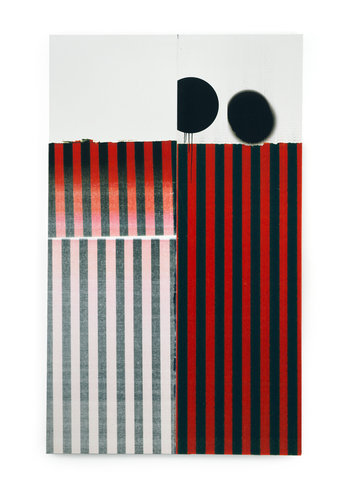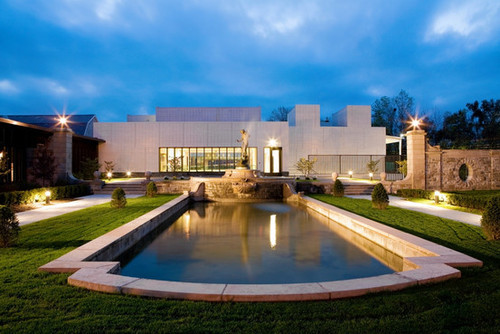LONDON—British authorities are searching for a man who took responsibility for defacing a valuable Mark Rothko canvas with black paint at the Tate Modern museum on Sunday afternoon.
The man walked up to one of Rothko's murals—an untitled 1958 painting often referred to as "Black on Maroon"—and tagged it with the words: "Vladimir Umanets '12, a potential piece of yellowism." The vandal then quickly left the building.

The incident was witnessed by Tim Wright, a 23-year-old marketing executive from Bristol, England, who said he "turned around and heard this scratching sound," only to see a young man finishing his letters on the Rothko painting.
"It was all very surreal," Mr. Wright said. "One minute he was sat down, and the next he had climbed over a little barrier and was knelt down doing his tag." Mr. Wright snapped a picture of the defaced painting—marked with the black letters in the bottom corner— and uploaded it to Twitter.
Vladimir Umanets, an artist working in London who has published a "Manifesto of Yellowism," claimed in several British media outlets on Monday, including ITV and the Guardian and Evening Standard newspapers, that he had defaced the painting, describing his act as art. Mr. Umanets told the Guardian that the incident would increase the value of the Rothko canvas.
"I don't want to spend a few months, even a few weeks, in jail." Mr. Umanets told ITV News. "But I do strongly believe in what I am doing, I have dedicated my life to this."
Mr. Umanets declined to comment to The Wall Street Journal.
A spokesman for the Metropolitan Police said authorities are looking for a suspect described as a white man in his 20s and have taken note of reports in the British media naming the alleged suspect.
Rothko, a Russian-American painter known for his abstract color fields, painted the murals in the late 1950s for the Four Seasons restaurant in New York's Seagram Building. The artist's decision to accept the commission was subversive, according to a Harper's Magazine piece by the late editor John Fischer, who famously recounted Rothko's hope that the art would "ruin the appetite of every son of a b— who ever eats in that room."
The paintings were never exhibited in the New York restaurant because Rothko decided to keep them. He gave a set of the now-famous murals to the Tate in 1969, just before he committed suicide.
The murals are an important part of Rothko's oeuvre because they mark the first time he created multiple paintings designed to surround the viewer, according to David Anfam, a Rothko expert and commissioning editor of fine art at British publisher Phaidon. Mr. Anfam says he thinks conservators will be able to repair the Tate's damaged canvas, which he says is likely worth tens of millions of dollars. In May, Rothko's 1961 painting "Orange Red Yellow" was sold at Christie's in New York for $86.9 million, becoming the most expensive Rothko work ever sold.
The Tate declined to comment on potential restoration.
"With the Seagram Murals, this was Rothko's first and seminal bid to create an entire environment—which is absolutely key—rather than just isolated individual works on canvas," Mr. Anfam said.
The incident Sunday served as a reminder of how vulnerable prized paintings can be when on display in high-traffic museums.
At the Tate on Sunday, two staffers who had been manning the room ran to summon security, but the vandal had left by time the guards arrived, Mr. Wright said. He said the museum soon evacuated the entire building, located across the Thames River from St. Paul's Cathedral.
The Tate confirmed in a statement that a visitor defaced one of Rothko's Seagram murals "by applying a small area of black paint with a brush to the painting." The museum declined to comment further.
Rothko's children, Kate Rothko Prizel and Christopher Rothko, also issued a statement, saying: "The Rothko family is greatly troubled by yesterday's occurrence but has full confidence that the Tate Gallery will do all in its power to remedy the situation."
The Rothko mural isn't the first work of art to be attacked in the name of art. In 2000, also at the Tate Modern, two performance artists urinated on Marcel Duchamp's sculpture "Fountain," itself a urinal. Four years earlier, Canadian artist Jubal Brown ate blue foods and purposefully vomited on a Piet Mondrian painting at the Museum of Modern Art in New York. A few months before, he had vomited in red hues on a different painting in Toronto.
-By Paul Sonne


 The
The 



![[image]](http://si.wsj.net/public/resources/images/PJ-BJ853_warhol_DV_20120925165257.jpg)
![[image]](http://si.wsj.net/public/resources/images/PJ-BJ852_warhol_DV_20120925165207.jpg)
